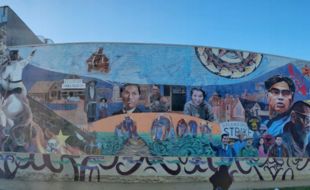To Us, To Those Like Us, Damn Few
From the Statue of Liberty to the Golden Gate Bridge, monuments and memorials depicting triumphs and tragedies alike riddle the American landscape. In a country made by the descendants of immigrants, their ancestors, most of which arrived on Ellis Island or Angel Island, likely witnessed the aforementioned landmarks as the first symbols of starting anew with both their belongings and identities. Monuments serve to physically memorialize the cultures and histories of different demographics; however, there is a particular struggle for Filipinos in the United States to maintain some semblance of solidarity due to their recent flux in immigration. In this digital exhibit, I will address how the monuments for a recent migratory group encapsulates the continuous transition from preserving an antecedent, ethnic authenticity to promoting a newfound, integrated identity.
To Us
Not including the Filipino American settlement in St. Malo, Louisiana in 1763, Filipino immigration into the United States started roughly two centuries ago, spiking in the aftermath of both the Spanish-American War and World War II ("Immigration"). However, the amendment to the Immigration and Naturalization Act in 1990 brought about the largest influx of migration in the late 20th century. Settling in cities across southern California, Filipino American populations quadrupled from half a million in 1980 to nearly two million by 2016 (Zong & Batalova).
Just five years after the 1990 amendment, Eliseo Art Silva, then 22 years old, painted the largest Filipino American mural in the United States. Dedicated on 24 June 1995 in Unidad Park, Los Angeles, "Gintong Kasaysayan, Gintong Panama" visually showcases 5,000 years of Philippine history. According to Silva, the two-part design is historical in "leading up to the awakening of Filipino national and political consciousness" and is representative of Filipino American workers, youth, and community. As the oldest of the three monuments in this digital exhibit, the mural embodies an initial desire to preserve one's identity when migrating elsewhere, and Silva fulfilled that goal by maintaining cultural originality in, quite fittingly, a concrete way.
To Those Like Us
Seven years later and just north of Unidad Park lies Historic Filipinotown, "Hi-Fi," an ethnic enclave in which designates a major settlement area for Filipinos during the immigration resurgence of the late 1990s and early 2000s. Comprised of Catholic churches and housing as far back as the 1940s, the area once known as Little Manila remains the cultural heart of Filipino Americans in southern California. However, Hi-Fi's changing demographics of incoming Mexican and Central American populations, as well as influence from other Asian American communities, challenge the neighborhood's sense of cultural unity.
Unlike those who came before, more recent immigrants in Hi-Fi will be met not by the first symbols of a new life from the side of ship but rather the competing businesses from neighoring Little Tokyo or Koreatown and the Hispanic majority in a historically Filipino community through a window a moving car. Despite uncertainty in the unified sense of identity, identity can be reborn to take on a new form, integrating into one that echoes with the idea of being uniquely American.
Damn Few
Located in the heart of Hi-Fi is the Filipino American WWII Veterans Memorial, a monument that exemplifies the reincarnated identity of Filipinos in the United States. Designed by Ceri Gaulke, inscriptions upon five asymmetric slabs of black granite commemorate the Filipinos and Filipino Americans that fought alongside the United States to reclaim their homeland from imperial Japan. With "kagitingan," or valor, 257,000 soldiers embraced an identity integrated into the American spirit. Decades later, the veterans still embrace this identity as they continue to fight; this time, however, the fight is for equality in their new home. As the newest monument, dedicated on November 2006, the veterans memorial epitomizes the dichotomy of the identity transition: the difficulties in preserving yet promoting an ever-changing and ever-conforming meaning of being a Filipino American.
Inscribed on the center slab of the monument is a quote by Faustino "Peping" Baclig: "Bataan was not our last battlefield. We are still fighting for equity." Although it does not compare to the atrocities of what happened in Bataan and the struggles in one of the lowest rungs of the American socioeconomic ladder, the conflict of identity neither remained in the Philippines nor was resolved in the United States. These monuments do not simply accomplish the physical task of memorializing a people, a community, or a war. From 5,000 years of history to 50 years of courage, these monuments present a timeline of the continuous integration towards a newfound semblance of solidarity while not forgetting the original identity that still exists within.
Works Cited
"Immigration History." Ethnogeriatrics, Stanford School of Medicine,
https://geriatrics.stanford.edu/ethnomed/filipino/fund/immigration-histo....
Zong, Jie and Jeanne Batalova. "Filipino Immigrants in the United States." Migration Information Source,
Migration Policy Institute, 14 Mar. 2018, https://www.migrationpolicy.org/article/filipino-immigrants-united-states.



7efc.jpg?itok=ntZyXyzb)


1c48.jpg?itok=uB6gCSo_)